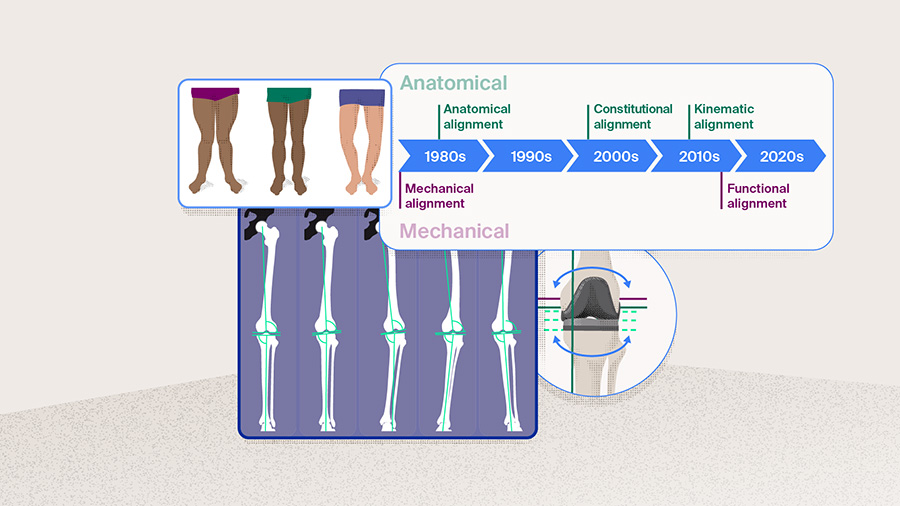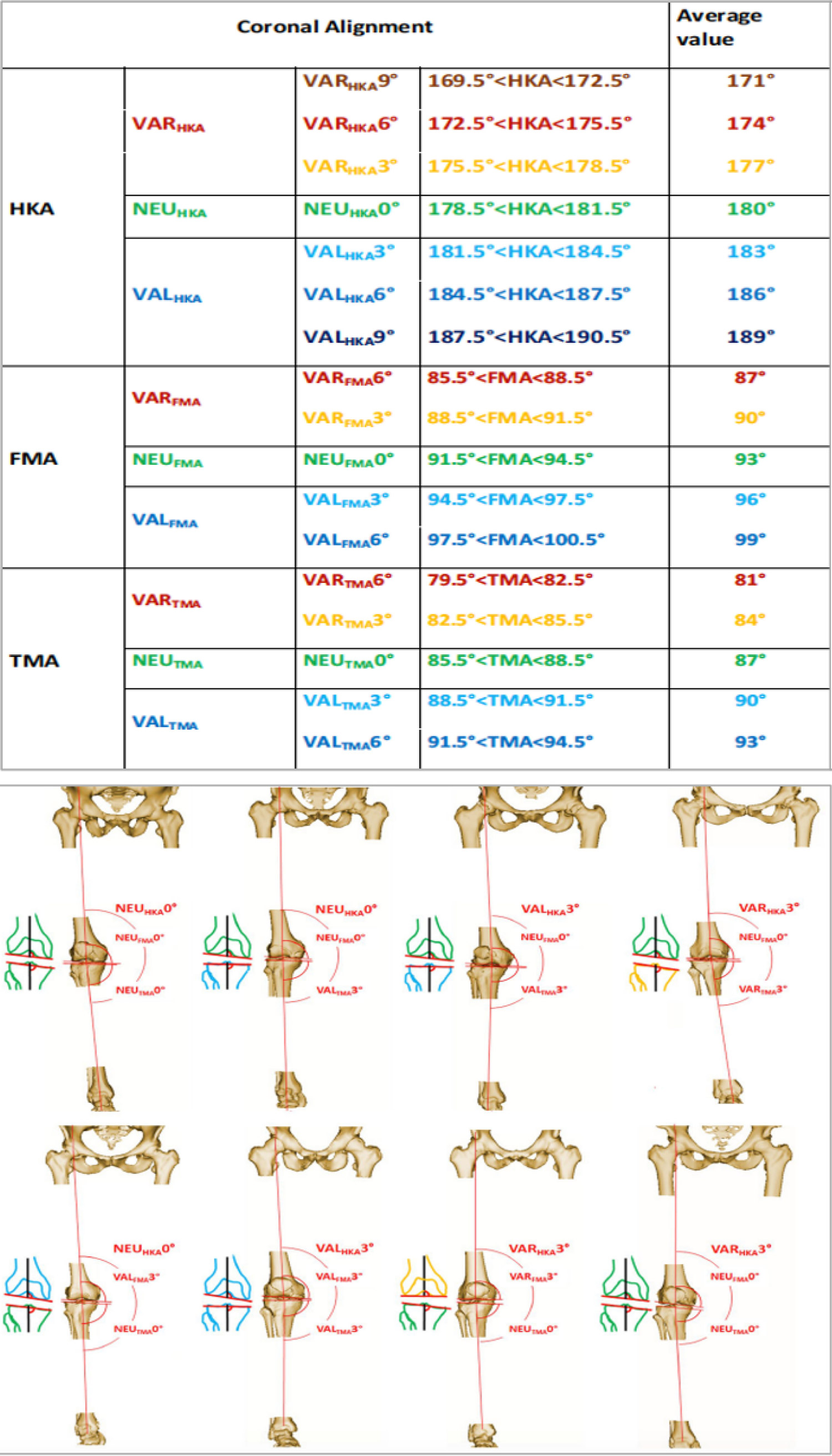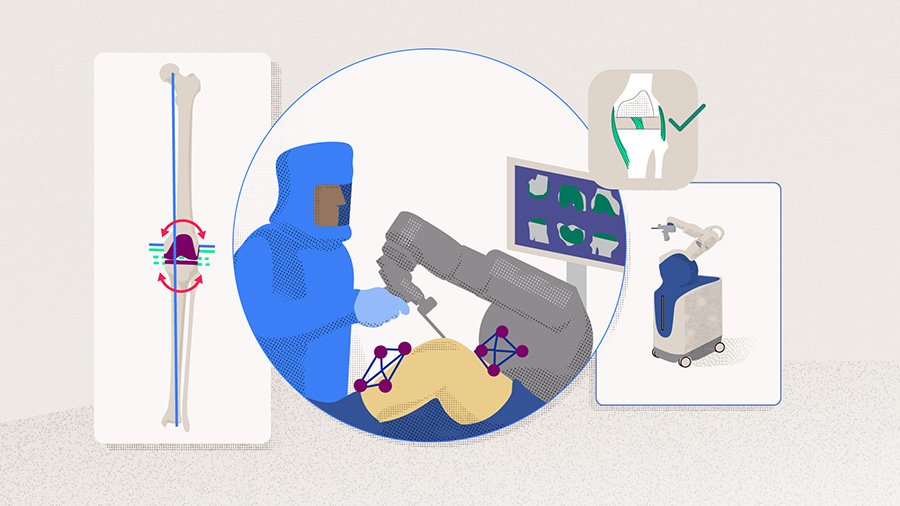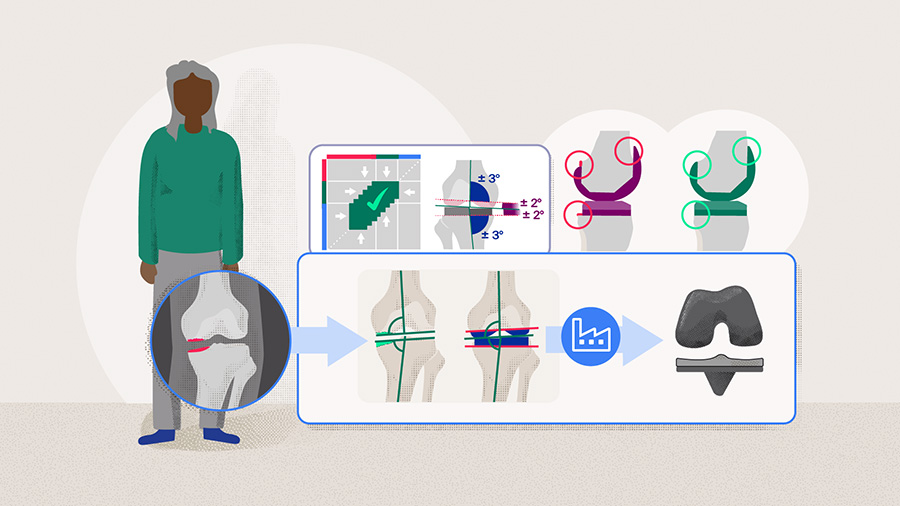Evolution of alignment concepts in total knee arthroplasty
Preview
Every knee is unique. So, why treat them all the same? Orthopedic surgeons now know that since the 1980s, the systematic approach of alignment for total knee arthroplasty (TKA) is suboptimal but there remains no clear consensus on the optimal alignment technique for TKA that gives the most reliable clinical outcomes. In addition, advances in technologies are bringing surgeons more opportunities to implement change in the alignment techniques for TKA. Here, Charles Rivière, an orthopedic surgeon at the Clinique du Sport Bordeaux-Mérignac, France describes the evolution of alignment in TKA in terms of the types of alignment options available to surgeons.

Charles Rivière
Clinique du Sport Bordeaux-Mérignac
Mérignac, France
Functional knee phenotypes
In recent years, surgeons have come to acknowledge that in the general nonarthritic population there is a vast variability in knee alignment, anatomy, laxity, and kinematics [1–3]. Functional knee phenotypes have been devised by analyzing coronal knee alignment parameters. In a study of 308 knees from 160 young nonarthritic participants, data showed an overall mean femoral mechanical angle (FMA) of 93.4° ± 2.0°and values ranged from 87.9° (distal femoral joint line slightly varus oriented) to 100° (distal femoral joint line significantly valgus oriented), and an overall mean tibial mechanical angle (TMA) of 87.2° ± 2.4° with a range of 81.3° (varus proximal tibial joint line) to 94.6° (valgus proximal tibial joint line) [4], demonstrating this variability in alignment in the general nonarthritic population. Gender differences could also be seen with women having more valgus alignment than men, but the most common femoral phenotype was neutral in both genders. Hirschmann and colleagues [5, 6] expanded on these findings and generated the novel classification for lower limb frontal alignment (Figure 1). If variability occurs in the general population, evidently, the arthritic knee population also shows highly variable coronal tibial and femoral alignment [7]. So, what can we do with this knowledge? Accepting this variability has created debate on how to deal with alignment in TKA for patients with arthritic knees, and clearly continuing to follow the one-size-fits-all approach will lead to further patient dissatisfaction secondary to persistent (or residual) knee symptoms [8]. Shifting from the concept of anatomical or mechanical alignment to kinematic or functional alignment for TKA is becoming the gold standard. But what do all these terms actually mean?
Read the full article with your AO login
- The timeline of alignment in total knee arthroplasty
- Understanding the types of alignment and when to use them
- What's the best alignment strategy to use?
- Conclusion
Additional AO resources
Access videos, tools, and other assets.
- Videos
- Upcoming events: AO Recon Course finder
Contributing experts
This series of articles was created with the support of the following specialists (in alphabetical order):

Michel Bonnin
Centre Orthopédique Santy
Lyon, France

Sébastien Lustig
Lyon North University Hospital
Lyon, France

Charles Rivière
Clinique du Sport Bordeaux-Mérignac
Mérignac, France
This issue was written by Antia Rodriguez-Villalon and Laura Kehoe, AO Innovation Translation Center, Clinical Science, Switzerland.
References
- Hirschmann MT, Becker R, Tandogan R, et al. Alignment in TKA: what has been clear is not anymore! Knee Surg Sports Traumatol Arthrosc. 2019 Jul;27(7):2037–2039.
- Hirschmann MT, Behrend H. Functional knee phenotypes: a call for a more personalised and individualised approach to total knee arthroplasty? Knee Surgery, Sports Traumatology, Arthroscopy. 2018 2018/10/01;26(10):2873–2874.
- Hirschmann MT, Hess S, Behrend H, et al. Phenotyping of hip-knee-ankle angle in young non-osteoarthritic knees provides better understanding of native alignment variability. Knee Surg Sports Traumatol Arthrosc. 2019 May;27(5):1378–1384.
- Hirschmann MT, Moser LB, Amsler F, et al. Phenotyping the knee in young non-osteoarthritic knees shows a wide distribution of femoral and tibial coronal alignment. Knee Surgery, Sports Traumatology, Arthroscopy. 2019 2019/05/01;27(5):1385–1393.
- Moser L, Hess S, Behrend H, et al. Functional knee phenotypes - A novel classification for the lower limb alignment based on the native alignment in young non-osteoarthritic patients. Orthopaedic Journal of Sports Medicine. 2020;8(5_suppl4):2325967120S2325900301.
- Hirschmann MT, Moser LB, Amsler F, et al. Functional knee phenotypes: a novel classification for phenotyping the coronal lower limb alignment based on the native alignment in young non-osteoarthritic patients. Knee Surgery, Sports Traumatology, Arthroscopy. 2019 2019/05/01;27(5):1394–1402.
- Hess S, Moser LB, Amsler F, et al. Highly variable coronal tibial and femoral alignment in osteoarthritic knees: a systematic review. Knee Surg Sports Traumatol Arthrosc. 2019 May;27(5):1368–1377.
- Gunaratne R, Pratt DN, Banda J, et al. Patient Dissatisfaction Following Total Knee Arthroplasty: A Systematic Review of the Literature. J Arthroplasty. 2017 Dec;32(12):3854–3860.
- Insall JN, Binazzi R, Soudry M, et al. Total knee arthroplasty. Clin Orthop Relat Res. 1985 Jan-Feb(192):13–22.
- Nam D, Nunley RM, Barrack RL. Patient dissatisfaction following total knee replacement: a growing concern? Bone Joint J. 2014 Nov;96-b(11 Supple A):96–100.
- Bourne RB, Chesworth BM, Davis AM, et al. Patient satisfaction after total knee arthroplasty: who is satisfied and who is not? Clin Orthop Relat Res. 2010 Jan;468(1):57–63.
- Hungerford DS, Krackow KA. Total joint arthroplasty of the knee. Clin Orthop Relat Res. 1985 Jan-Feb(192):23–33.
- Almaawi AM, Hutt JRB, Masse V, et al. The Impact of Mechanical and Restricted Kinematic Alignment on Knee Anatomy in Total Knee Arthroplasty. J Arthroplasty. 2017 Jul;32(7):2133–2140.
- Kayani B, Konan S, Tahmassebi J, et al. A prospective double-blinded randomised control trial comparing robotic arm-assisted functionally aligned total knee arthroplasty versus robotic arm-assisted mechanically aligned total knee arthroplasty. Trials. 2020 Feb 18;21(1):194.
- Lustig S, Sappey-Marinier E, Fary C, et al. Personalized alignment in total knee arthroplasty: current concepts. SICOT J. 2021;7:19.
- Rivière C, Villet L, Bouchard Roby G. Anatomical versus mechanical joint reconstruction: time to pick your surgical philosophy! Knee Surg Sports Traumatol Arthrosc. 2022 Sep;30(9):2890–2894.
- Oussedik S, Abdel MP, Victor J, et al. Alignment in total knee arthroplasty. Bone Joint J. 2020 Mar;102-b(3):276–279.
- Rivière C, Iranpour F, Auvinet E, et al. Mechanical alignment technique for TKA: Are there intrinsic technical limitations? Orthopaedics & Traumatology: Surgery & Research. 2017 2017/11/01/;103(7):1057–1067.
- Lustig S, Sappey-Marinier E, Fary C, et al. Personalized alignment in total knee arthroplasty: current concepts. SICOT-J. 2021;7:19.
- Rivière C, Lazic S, Boughton O, et al. Current concepts for aligning knee implants: patient-specific or systematic? EFORT Open Rev. 2018 Jan;3(1):1–6.
- Vendittoli PA, Martinov S, Blakeney WG. Restricted Kinematic Alignment, the Fundamentals, and Clinical Applications. Front Surg. 2021;8:697020.
- Winnock de Grave P, Luyckx T, Claeys K, et al. Higher satisfaction after total knee arthroplasty using restricted inverse kinematic alignment compared to adjusted mechanical alignment. Knee Surg Sports Traumatol Arthrosc. 2022 Feb;30(2):488–499.
- Dossett HG, Estrada NA, Swartz GJ, et al. A randomised controlled trial of kinematically and mechanically aligned total knee replacements: two-year clinical results. Bone Joint J. 2014 Jul;96-b(7):907–913.
- Dossett HG, Swartz GJ, Estrada NA, et al. Kinematically versus mechanically aligned total knee arthroplasty. Orthopedics. 2012 Feb 17;35(2):e160–169.
- Shelton TJ, Gill M, Athwal G, et al. Outcomes in Patients with a Calipered Kinematically Aligned TKA That Already Had a Contralateral Mechanically Aligned TKA. J Knee Surg. 2021 Jan;34(1):87–93.
- Luo Z, Zhou K, Peng L, et al. Correction to: Similar results with kinematic and mechanical alignment applied in total knee arthroplasty. Knee Surgery, Sports Traumatology, Arthroscopy. 2020 2020/06/01;28(6):1736–1741.
- Luo Z, Zhou K, Peng L, et al. Similar results with kinematic and mechanical alignment applied in total knee arthroplasty. Knee Surgery, Sports Traumatology, Arthroscopy. 2020 2020/06/01;28(6):1720–1735.





